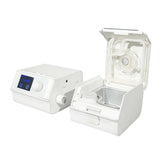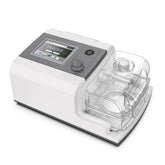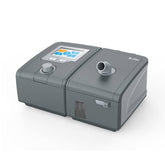Understanding the Differences between CPAP and BiPAP Machines: When is BiPAP a Better Option?
If you're dealing with sleep apnea or any other respiratory issue, you've likely heard of CPAP and BiPAP machines. These machines are designed to help you breathe easier and get a better night's rest, but they work in different ways. In this article, we'll explore the differences between CPAP and BiPAP machines, and help you understand when BiPAP may be a better option for you.
CPAP vs. BiPAP: What's the Difference?
CPAP stands for Continuous Positive Airway Pressure. A CPAP machine delivers a constant flow of air pressure to keep your airway open while you sleep. This pressure helps prevent your airway from collapsing or narrowing, which can lead to snoring, interrupted sleep, and other health issues.
BiPAP, on the other hand, stands for Bilevel Positive Airway Pressure. BiPAP machines deliver two different levels of air pressure: a higher pressure when you inhale, and a lower pressure when you exhale. This can be more comfortable for some people, as it allows them to breathe more easily.
What Is a BiPAP Machine, and How Does It Work?
A BiPAP (Bilevel Positive Airway Pressure) machine is a type of non-invasive
ventilation device that helps people with respiratory issues breathe more easily. It delivers two levels of air pressure: a higher pressure when you inhale, and a lower pressure when you exhale. This can be more comfortable for some people than a CPAP (Continuous Positive Airway Pressure) machine, which delivers a constant flow of air pressure.
A BiPAP machine works by using a small mask that fits over your nose and/or mouth. The machine delivers air pressure through the mask, which helps keep your airway open while you sleep. When you inhale, the machine delivers a higher pressure, which can help stimulate your breathing muscles and make it easier to take a breath. When you exhale, the machine delivers a lower pressure, which can help reduce the effort required to exhale.
BiPAP machines are often used to treat sleep apnea, a common condition in which your breathing pauses or becomes shallow while you sleep. They can also be helpful for people with other respiratory issues, such as chronic obstructive pulmonary disease (COPD), as well as those who have central sleep apnea or complex sleep apnea syndrome.
To determine if a BiPAP machine is right for you, you should talk to your doctor. They can evaluate your symptoms and recommend the best treatment option for your specific needs. A BiPAP machine may be recommended if you have trouble tolerating the constant pressure of a CPAP machine, or if you have a more complex respiratory issue that requires different levels of air pressure. Overall, a BiPAP machine can help you breathe more easily and get a better night's rest.
Benefits of BiPAP Therapy
\BiPAP (Bilevel Positive Airway Pressure) therapy has several benefits for individuals with respiratory issues, including:
Improved breathing: BiPAP therapy provides two levels of air pressure to help individuals breathe more easily. The higher pressure during inhalation can help stimulate the breathing muscles and make it easier to take a breath, while the lower pressure during exhalation can reduce the effort required to exhale.
Better sleep quality: By helping individuals breathe more easily, BiPAP therapy can improve sleep quality and reduce sleep disruptions. This can lead to increased energy, better concentration, and improved overall health.
Customizable settings: BiPAP machines can be customized to deliver different levels of air pressure based on an individual's specific needs. This can be helpful for individuals with complex respiratory issues or those who have trouble tolerating the constant pressure of a CPAP machine.
Non-invasive: BiPAP therapy is non-invasive, meaning it does not require surgery or any other invasive procedures. It is delivered through a mask that fits over the nose and/or mouth, making it a relatively simple and easy-to-use treatment option.
Potential for long-term benefits: By helping to improve respiratory function and reduce sleep disruptions, BiPAP therapy can provide long-term benefits for individuals with respiratory issues. This can help improve overall health and quality of life.
Overall, BiPAP therapy can be an effective treatment option for individuals with respiratory issues, providing improved breathing, better sleep quality, and customizable settings. As with any medical treatment, it is important to work with a medical professional to determine the best treatment plan for your specific needs.
Downsides of BiPAP
While BiPAP (Bilevel Positive Airway Pressure) therapy can provide significant benefits for individuals with respiratory issues, there are also some potential downsides to consider:
Discomfort: While some individuals may find BiPAP therapy comfortable, others may experience discomfort or difficulty adjusting to the pressure changes during inhalation and exhalation. This can lead to difficulty sleeping or reduced compliance with the therapy.
Skin irritation: The mask used for BiPAP therapy can cause skin irritation or pressure sores, particularly if the mask does not fit properly or is worn for extended periods of time.
Claustrophobia: The mask used for BiPAP therapy can feel constricting or uncomfortable for individuals with claustrophobia or anxiety related to wearing a mask over their face.
Cost: BiPAP machines can be more expensive than CPAP machines, and the cost may not be fully covered by insurance. This can make the therapy less accessible for some individuals.
Maintenance: BiPAP machines require regular cleaning and maintenance to ensure they function properly and remain effective. This can be a time-consuming and potentially costly process.
Overall, while BiPAP therapy can provide significant benefits for individuals with respiratory issues, it is important to consider the potential downsides as well. Working with a medical professional to determine the best treatment plan and ensure proper use and maintenance of the BiPAP machine can help minimize these downsides and maximize the potential benefits
Uses and Indications for BiPAP Therapy
Uses and Indications for BiPAP Therapy
BiPAP therapy is primarily used to treat sleep-related breathing disorders such as obstructive sleep apnea (OSA). OSA occurs when the airway becomes partially or completely blocked during sleep, causing disruptions in breathing that can lead to loud snoring, daytime fatigue, and other health complications.
BiPAP therapy may also be used to treat other respiratory issues, including:
Chronic Obstructive Pulmonary Disease (COPD): COPD is a progressive lung disease that makes it difficult to breathe. BiPAP therapy can help relieve symptoms such as shortness of breath and chronic cough.
Congestive Heart Failure (CHF): CHF is a condition in which the heart is unable to pump enough blood to meet the body's needs. BiPAP therapy can help improve breathing and oxygen levels in individuals with CHF.
Neuromuscular Disorders: Neuromuscular disorders such as muscular dystrophy or ALS can weaken the muscles responsible for breathing. BiPAP therapy can help improve respiratory function and overall quality of life for individuals with these conditions.
Obesity Hypoventilation Syndrome (OHS): OHS is a breathing disorder that occurs in individuals who are severely overweight. BiPAP therapy can help improve breathing and oxygen levels in individuals with OHS.
Overall, BiPAP therapy can be a highly effective treatment option for individuals with respiratory issues, particularly those who have trouble tolerating the constant pressure of a CPAP machine or who require more customized therapy. It is important to discuss your specific needs and medical history with your healthcare provider to determine whether BiPAP therapy is the right treatment option for you.
Understanding the Different BiPAP Modes (BiPAP ST and AVAPS)
BiPAP machines offer different modes of therapy that allow for more customized treatment based on individual needs. The two most common modes are BiPAP ST and BiPAP AVAPS.
- BiPAP ST (Spontaneous/Timed): BiPAP ST is a mode that provides both spontaneous breathing and timed breaths. This mode is commonly used for individuals who have irregular breathing patterns or who require a higher pressure setting during the night. In this mode, the machine will deliver a set number of breaths per minute, with additional breaths triggered by the individual's own breathing efforts.
- BiPAP AVAPS (Average Volume Assured Pressure Support): BiPAP AVAPS is a mode that adjusts the pressure support based on the individual's respiratory needs. This mode is commonly used for individuals who have complex respiratory issues, such as neuromuscular disorders, obesity hypoventilation syndrome, or chronic obstructive pulmonary disease. In this mode, the machine will monitor the individual's breathing patterns and adjust the pressure support to maintain a consistent tidal volume (amount of air breathed in and out) with each breath.
Both BiPAP ST and BiPAP AVAPS offer more customized therapy than standard CPAP machines, which deliver a constant pressure throughout the night. It is important to discuss your specific needs with your healthcare provider to determine which mode is the best fit for you. Additionally, it is crucial to work closely with your healthcare provider to ensure that the machine is properly calibrated and adjusted for optimal therapy.
Why Are BiPAP Machines More Expensive Than CPAP Machines?
BiPAP machines are more expensive than CPAP machines due to their advanced technology and additional features. BiPAP machines offer more customized therapy options compared to CPAP machines, which deliver a constant pressure throughout the night. BiPAP machines can detect and respond to changes in the individual's breathing pattern, adjusting the pressure support and breaths delivered accordingly.
Additionally, BiPAP machines offer more advanced modes of therapy, such as BiPAP ST and BiPAP AVAPS, which provide more targeted therapy for individuals with complex respiratory issues. These modes require more advanced technology and software, which increases the cost of the machine.
Do I Need a Different Mask for My BiPAP Machine?
Individuals using a BiPAP machine may not necessarily need a different mask compared to those using a CPAP machine. However, some individuals may benefit from a mask that provides a better seal to accommodate the higher pressures delivered by the machine.
In general, the type of mask used for BiPAP therapy is largely dependent on individual comfort and preference, as well as the specific therapy needs. Some individuals may find that a full-face mask is more comfortable for BiPAP therapy, as it covers both the nose and mouth and may reduce the feeling of air pressure. Others may prefer a nasal mask, which covers only the nose.
It is important to discuss mask options with your healthcare provider or a respiratory therapist who can help you find a mask that fits properly and provides the most effective therapy. They can also provide guidance on how to adjust the mask to ensure a proper seal and avoid air leaks, which can interfere with the effectiveness of the therapy. In some cases, a different mask may be recommended if the individual is experiencing air leaks or discomfort during therapy.
When Is BiPAP a Better Sleep Apnea Treatment Option Than CPAP?
BiPAP therapy may be a better sleep apnea treatment option than CPAP in certain cases, such as:
- High Pressure Needs: Individuals with sleep apnea who require higher pressure settings may find BiPAP therapy more comfortable than CPAP. BiPAP machines can provide a lower pressure during exhalation, which may make breathing easier and reduce discomfort.
- COPD: Individuals with chronic obstructive pulmonary disease (COPD) may benefit from BiPAP therapy, as it can help improve their breathing and reduce the work of breathing. BiPAP therapy can provide a higher level of pressure support during inhalation and a lower level of pressure support during exhalation, which can be beneficial for individuals with COPD.
- Central Sleep Apnea: Individuals with central sleep apnea (CSA) may benefit from BiPAP therapy, as it can help regulate their breathing. BiPAP therapy can be set to provide a backup respiratory rate, which can help individuals with CSA maintain a more regular breathing pattern.
- Complex Respiratory Issues: Individuals with complex respiratory issues, such as neuromuscular disorders or obesity hypoventilation syndrome, may benefit from BiPAP therapy, as it can provide a more customized level of pressure support.
It is important to discuss the best treatment option for your specific needs with your healthcare provider, who can recommend the most appropriate therapy based on your medical history, sleep study results, and individual preferences.
Conclusion
CPAP and BiPAP machines are both effective at treating sleep apnea and other respiratory issues. However, they work in different ways, and BiPAP may be a better option for some people. If you're struggling to tolerate a CPAP machine or have complex sleep apnea, a BiPAP machine may be a more effective treatment option. As always, it's important to talk to your doctor about your symptoms and concerns, and work together to find the best treatment plan for you.







